Mud volcano

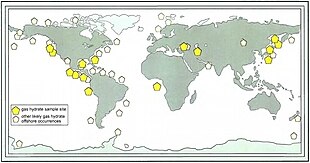
Amud volcanoormud domeis alandformcreated by the eruption ofmudorslurries,water and gases.[1][2][3]Several geological processes may cause the formation of mud volcanoes. Mud volcanoes are not trueigneousvolcanoesas they do not producelavaand are not necessarily driven bymagmaticactivity. Mud volcanoes may range in size from merely 1 or 2 meters high and 1 or 2 meters wide, to 700 meters high and 10 kilometers wide.[4]Smaller mud exudations are sometimes referred to as mud-pots.
The mud produced by mud volcanoes is mostly formed as hot water, which has been heated deep below the Earth's surface, begins to mix and blend with subterranean mineral deposits, thus creating the mud slurry exudate. This material is then forced upwards through a geological fault or fissure due to local subterranean pressure imbalances. Mud volcanoes are associated withsubduction zonesand about 1100 have been identified on or near land. The temperature of any given active mud volcano generally remains fairly steady and is much lower than the typical temperatures found in igneous volcanoes. Mud volcano temperatures can range from near 100 °C (212 °F) to occasionally 2 °C (36 °F), some being used as popular "mud baths".[citation needed]
About 86% of the gas released from these structures ismethane,with much lesscarbon dioxideandnitrogenemitted. Ejected materials are most often a slurry of fine solids suspended in water that may contain a mixture ofsalts,acidsand varioushydrocarbons.[citation needed]
Possible mud volcanoes have been identified onMars.[5]
Details[edit]

A mud volcano may be the result of apiercement structurecreated by a pressurizedmuddiapirthat breaches the Earth's surface or ocean bottom. Their temperatures may be as low as the freezing point of the ejected materials, particularly when venting is associated with the creation ofhydrocarbonclathrate hydratedeposits. Mud volcanoes are often associated withpetroleumdeposits and tectonicsubductionzones andorogenic belts;hydrocarbon gases are often erupted. They are also often associated withlava volcanoes;in the case of such close proximity, mud volcanoes emit incombustible gases includinghelium,whereas lone mud volcanoes are more likely to emitmethane.
Approximately 1,100 mud volcanoes have been identified on land and in shallow water. It has been estimated that well over 10,000 may exist oncontinental slopesandabyssal plains.
Features[citation needed][edit]
- Gryphon: steep-sided cone shorter than 3 meters that extrudes mud
- Mud cone: high cone shorter than 10 meters that extrudes mud and rock fragments
- Scoria cone: cone formed by heating of mud deposits during fires
- Salse: water-dominated pools with gas seeps
- Spring: water-dominated outlets smaller than 0.5 metres
- Mud shield
Emissions[edit]

Most liquid and solid material is released during eruptions, but seeps occur during dormant periods.
The mud is rich inhalite(rock salt).[citation needed]
First-order estimates of mud volcano emissions have been made (1 Tg = 1 million metric tonnes).
- 2002: L. I. Dimitrov estimated that 10.2–12.6Tg/yr of methane is released from onshore and shallow offshore mud volcanoes.
- 2002: Etiope and Klusman estimated at least 1–2 and as much as 10–20 Tg/yr of methane may be emitted from onshore mud volcanoes.
- 2003: Etiope, in an estimate based on 120 mud volcanoes: "The emission results to be conservatively between 5 and 9 Tg/yr, that is 3–6% of the natural methane sources officially considered in theatmospheric methanebudget. The total geologic source, including MVs (this work), seepage from seafloor (Kvenvolden et al., 2001), microseepage in hydrocarbon-prone areas and geothermal sources (Etiope and Klusman, 2002), would amount to 35–45 Tg/yr. "[6]
- 2003: analysis by Milkov et al. suggests that the global gas flux may be as high as 33 Tg/yr (15.9 Tg/yr during quiescent periods plus 17.1 Tg/yr during eruptions). Six teragrams per year ofgreenhouse gasesare from onshore and shallow offshore mud volcanoes. Deep-water sources may emit 27 Tg/yr. Total may be 9% of fossil CH4missing in the modern atmospheric CH4budget, and 12% in the preindustrial budget.[7]
- 2003: Alexei Milkov estimated approximately 30.5 Tg/yr of gases (mainly methane and CO2) may escape from mud volcanoes to the atmosphere and the ocean.[8]
- 2003: Achim J. Kopf estimated 1.97×1011to 1.23×1014m³ of methane is released by all mud volcanoes per year, of which 4.66×107to 3.28×1011m³ is from surface volcanoes.[9]That converts to 141–88,000 Tg/yr from all mud volcanoes, of which 0.033–235 Tg is from surface volcanoes.
Locations[edit]
Europe[edit]

Dozens of mud volcanoes are located on theTaman PeninsulaofRussiaand theKerch PeninsulaofCrimea,Ukraine along with the south-western portion ofBulgarianearRupite.InItaly,they are located in Emilia-Romagna (Salse di Nirano and Salse di Regnano), in the northern front of theApenninesas well as the southern part (Bolle della Malvizza), and inSicily.On 24 August 2013, a mud volcano appeared in the center of the via Coccia di MortoroundaboutinFiumicinonearRome.[10][11]
Mud volcanoes are located in theBerca Mud Volcanoesnear Berca inBuzău County,Romania,close to theCarpathian Mountains.[12]They were declared a natural monument in 1924.
Asia[edit]
Central Asia, The Caucasus, and The Caspian Sea[edit]
Many mud volcanoes exist on the shores of theBlack SeaandCaspian Sea.Tectonicforces and large sedimentary deposits around the latter have created several fields of mud volcanoes, many of them emitting methane and other hydrocarbons. Features over 200 metres (656 ft) high occur inAzerbaijan,with large eruptions sometimes producing flames of similar scale.[citation needed]
Georgia[edit]
There are mud volcanoes inGeorgia,such as the one atAkhtala.[13]
Turkmenistan[edit]
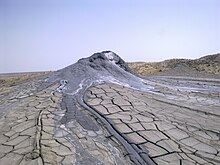
Turkmenistanis home to numerous mud volcanoes, mainly in the western part of the country includingCheleken Peninsula,which borders the Caspian Sea.[14]
Iran and Pakistan (Makran Mountain Range)[edit]
IranandPakistanpossess mud volcanoes in theMakranrange of mountains in the south of the two countries. A large mud volcano is located inBalochistan,Pakistan. It is known asBaba Chandrakup(literally Father Moonwell) on the way toHinglajand is aHindupilgrimsite.[15]
Azerbaijan[edit]

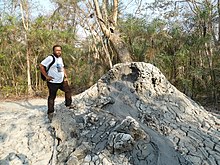
Azerbaijanand itsCaspiancoastline are home to nearly400 mud volcanoes,more than half the total throughout the continents.[16]Most mud volcanoes in Azerbaijan are active; some are protected by the Azerbaijan Ministry of Ecology and Natural Resources, and the admission of people, for security reasons, is prohibited.[17]In 2001, one mud volcano 15 kilometres (9 mi) fromBakumade world headlines when it started ejecting flames 15 metres (49 ft) high.[18]
In Azerbaijan, eruptions are driven from a deep mud reservoir which is connected to the surface even during dormant periods, when seeping water shows a deep origin.Seepshave temperatures that are generally above ambient ground temperature by 2 °C (3.6 °F) – 3 °C (5.4 °F).[19]
On 4 July 2021, a mud volcano eruption onDashli Islandin the Caspian Sea, near an oil platform off the coast of Azerbaijan, caused a massive explosion and fireball, which was seen across the region, including from the capitalBaku,which is 74 kilometres (46 mi) to the north. The flames towered 500 metres (1,640 ft) into the air.[20][21][22]There were no reports of injuries or damage to any oil platforms.[23]The last previous volcanic eruption on the island was recorded in 1945 and the preceding one in 1920.[24]
India[edit]
Extensive mud volcanism occurs on the Andamanaccretionary prism,located at theAndaman Islandsin theIndian Ocean.[25]
Indonesia[edit]
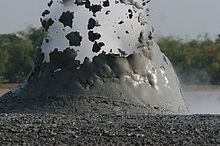
Mud volcanism is a common phenomenon inIndonesiawith dozens of structures present onshore and offshore.[26][27]
The IndonesianLusi mud eruptionis a hybrid mud volcano, driven by pressure from steam and gas from a nearby (igneous) volcanic system, and from natural gas. Geochemical, petrography and geophysical results reveal that it is asediment-hosted[clarification needed]hydrothermal system connected at depth with the neighboringArjuno-Welirangvolcanic complex.[28][29][30][31][32]
Drilling or anearthquake[33][27]in thePorongsubdistrict ofEast Javaprovince,Indonesia,may have resulted in theSidoarjo mud flowon 29 May 2006.[34][35][36]The mud covered about 440 hectares, 1,087 acres (4.40 km2) (2.73 mi2), and inundated four villages, homes, roads, rice fields, and factories, displacing about 24,000 people and killing 14. The gas exploration company involved was operated byPT Lapindo Brantasand the earthquake that may have triggered the mud volcano was the 6.4 magnitude[citation needed]Yogyakarta earthquakeof 27 May 2006. According to geologists who have been monitoring Lusi and the surrounding area, the system is beginning to show signs of catastrophic collapse. It was forecasted that the region could sag the vent and surrounding area by up to 150 metres (490 ft) in the next decade. In March 2008, the scientists observed drops of up to 3 metres (9.8 ft) in one night. Most of the subsidence in the area around the volcano is more gradual, at around 1 millimetre (0.039 in) per day. A study by a group of Indonesian geoscientists led by Bambang Istadi predicted the area affected by the mudflow over a ten-year period.[37]More recent studies carried out in 2011 predict that the mud will flow for another 20 years, or even longer.[38]Now namedLusi– a contraction ofLumpurSidoarjo,wherelumpuris the Indonesian word for "mud" – the eruption represent an active hybrid system.
In theSuwohdepression in Lampung, dozens of mud cones and mud pots varying in temperature are found.[citation needed]
InGrobogan,Bledug Kuwu mud volcano erupts at regular intervals,[39]about every 2 or 3 minutes.
Iran[edit]

There are many mud volcanoes inIran:in particular, in the provinces ofGolestan,Hormozgan,andSistan and Baluchestan,wherePirgelis located.
Mariana Forearc[edit]
There are 10 active mud volcanoes in theIzu–Bonin–Mariana Arcwhich can be found along a north to south trend, parallel to the Mariana trench.[40]The material erupted at these mud volcanoes consists primarily of blue and greenserpentinitemud which contains fresh and serpentinizedperidotitematerial from the subduction channel. Fluid from the descendingPacific Plateis released by dehydration and alteration of rocks and sediment.[40]This fluid interacts withmaficandultramaficrocks in the descending Pacific Plate and overridingPhilippine Plate,resulting in the formation of serpentinite mud.[41]All of these mud volcanoes are associated with faults, indicating that the faults act as conduits for the serpentine mud to migrate from the subduction channel to the surface.[40]These mud volcanoes are large features on the forearc, the largest of which has a diameter of ~50 kilometres (31 mi) and is over 2 kilometres (1.2 mi) high.
Pakistan[edit]

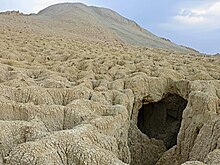
InPakistanthere are more than 130 active mud volcanoes or vents inBalochistanprovince; there are about 10 locations with clusters of mud volcanoes. In the west, inGwadarDistrict, the mud volcanoes are very small and mostly sit in the south of Jabal-e-Mehdi toward Sur Bandar. Many more are in the northeast ofOrmara.The remainder are inLasbela Districtand are scattered between south of Gorangatti on KohHinglajto Koh Kuk in the North of Miani Hor in the Hangol Valley. In this region, the heights of mud volcanoes range between 300 and 2,600 feet (91.4 and 792.5 m).[citation needed]The most famous isChandragup.The biggest crater is of V15 mud volcano found at 25°33'13.63 "N. 65°44'09.66" E is about 450 feet (137.16 m) in diameter. Most mud volcanoes in this region are in out-of-reach areas having very difficult terrain.Mount Mehdi mud volcanonear Miani Hor is also famous for large mud glacier around its caldera. Dormant mud volcanoes stand like columns of mud in many other areas.[citation needed]
Philippines[edit]
In theTurtle Islands,in theprovinceofTawi-Tawi,the southwestern edge of thePhilippinesborderingMalaysia,presence of mud volcanoes are evident on three of the islands – Lihiman, Great Bakkungan and Boan Islands. The northeastern part of Lihiman Island is distinguished for having a more violent kind of mud extrusions mixed with large pieces of rocks, creating a 20-m (66-ft) wide crater on that hilly part of the island.[42]Such extrusions are reported to be accompanied by mild earthquakes and evidence of extruded materials can be found high in the surrounding trees. Submarine mud extrusions off the island have been observed by local residents.[43]
Other Asian locations[edit]
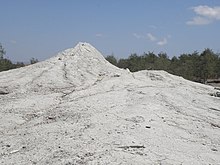
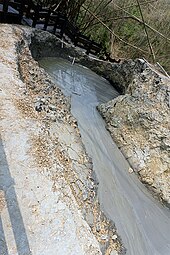
- There are a number of mud volcanoes inXin gian g.
- There are mud volcanoes atMinbu Township,Magway Region,Myanmar (Burma). There is a local belief that these mud volcanoes are the refuge of mythologicalNāga.
- There are two active mud volcanoes in southern Taiwan and several inactive ones. The Wushan Mud Volcanoes are in theYanchao DistrictofKaohsiung City.There are active mud volcanoes in Wandan township of Pingtung County.
- There are mud volcanoes on the island ofPulau Tiga,off the western coast of the Malaysian state ofSabahon Borneo.
- The Meritam Volcanic Mud, locally called the 'lumpur bebuak', located about 35 kilometres (22 mi) fromLimbang,Sarawak,Malaysia is a tourist attraction.[44]
- A drilling accident offshore ofBruneionBorneoin 1979 caused a mud volcano which took 20relief wellsand nearly 30 years to halt.
- Active mud volcanoes occur inOesilo(Oecusse District,East Timor). A mud volcano inBibiluto(Viqueque District) erupted between 1856 and 1879.[45]
North America[edit]

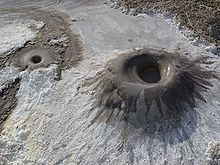
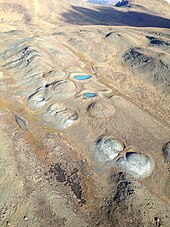
Mud volcanoes of the North American continent include:
- A field of small (<2 metres (6.6 ft) high) fault-controlled, cold mud volcanoes is onCalifornia'sMendocino Coast,nearGlenblairandFort Bragg, California.The fine-grained clay is occasionally harvested by local potters.[46]
- ShrubandKlawasi mud volcanoesin theCopper River basinby theWrangell Mountains,Alaska.Emissions are mostly CO2and nitrogen; the volcanoes are associated withmagmaticprocesses.
- An unnamed mud volcano 30 metres (98 ft) high and with a top about 100 metres (328 ft) wide, 24 kilometres (15 mi) offRedondo Beach, California,and 800 metres (2,620 ft) under the surface of thePacific Ocean.
- A field of small (<3 metres (9.8 ft)) mud volcanoes in theSalton Seageothermal area near the town ofNiland, California.[47]Emissions are mostly CO2.One, known as theNiland Geyser,continues to move erratically.[48]
- Smooth Ridge mud volcano in 1,000 metres (3,280 ft) of water nearMonterey Canyon,California.
- Kaglulik mud volcano, 43 metres (141 ft) under the surface of theBeaufort Sea,near the northern boundary ofAlaskaandCanada.Petroleumdeposits are believed to exist in the area.
- Maquinnamud volcano, located 16–18 kilometres (9.9–11.2 mi) west ofVancouver Island,British Columbia,Canada.
Yellowstone's "Mud Volcano"[edit]
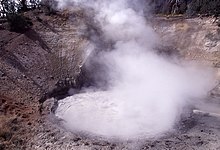
The name ofYellowstone National Park's "Mud Volcano" feature and the surrounding area is misleading; it consists ofhot springs,mud potsandfumaroles,rather than a true mud volcano. Depending upon the precise definition of the termmud volcano,the Yellowstone formation could be considered a hydrothermal mud volcano cluster. The feature is much less active than in its first recorded description, although the area is quite dynamic. Yellowstone is an activegeothermalarea with a magma chamber near the surface, and active gases are chiefly steam, carbon dioxide, andhydrogen sulfide.
However, there are mud volcanoes and mud geysers elsewhere in Yellowstone.[49]One, the "Vertically Gifted Cyclic Mud Pot" sometimes acts as a geyser, throwing mud up to 30 feet high.
The mud volcano feature in Yellowstone was previously a mound until a thermal explosion in the 1800s ripped it apart.[50][page needed]
Caribbean[edit]

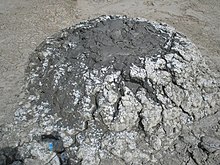
There are many mud volcanoes inTrinidad and Tobagoin theCaribbean,nearoil reservesin southern parts of the island ofTrinidad.As of 15 August 2007, the mud volcano titled the Moruga Bouffle was said to being spitting up methane gas which shows that it is active. There are several other mud volcanoes in the tropical island which include:
- theDevil's Woodyardmud volcano near New Grant,Princes Town,Trinidad and Tobago
- theMoruga Bouffemud volcano nearMoruga
- the Digity mud volcano inBarrackpore
- thePiparomud volcano
- theChathammud volcano underwater in theColumbus Channel;this mud volcano periodically produces a short-lived island.
- the Erin Bouffe mud volcano near Los Iros beach
- L'eau Michel mud volcano in Bunsee Trace, Penal
A number of large mud volcanoes have been identified on the Barbados accretionary complex, offshoreBarbados.[51]
South America[edit]
Venezuela[edit]

The eastern part ofVenezuelacontains several mud volcanoes (or mud domes), all of them having an origin related to oil deposits. The mud of 6 kilometres (3.7 mi) fromMaturín,contains water, biogenic gas, hydrocarbons and an important quantity of salt. Cattle from thesavannaoften gather around to lick the dried mud for its salt content.[citation needed]
Colombia[edit]
VolcanEl Totumo,[52]which marks the division betweenBolívarandAtlanticoinColombia.This volcano is approximately 50 feet (15 m) high and can accommodate 10 to 15 people in its crater; many tourists and locals visit this volcano due to the alleged medicinal benefits of the mud; it is next to acienaga,or lake. This volcano is under legal dispute between the Bolívar and Atlántico Departamentos because of its tourist value.[citation needed]
Africa[edit]
This sectionneeds expansion.You can help byadding to it.(March 2023) |
Australasia[edit]
New Zealand[edit]
As well as theRunaruna Mud Volcanothe size of the splatter cones associated with some of New Zealands many geothermalmud pools or mudpotsmight qualify, depending upon definition.
Possible mud volcanoes on Mars[edit]
-
Wide view of field of mud volcanoes, as seen by HiRISE under HiWish program
-
Close view of mud volcanoes, as seen by HiRISE under HiWish program
-
Close view of mud volcanoes and boulders, as seen by HiRISE under HiWish program
-
Wide view of mud volcanoes, as seen by HiRISE under HiWish program
-
Close view of mud volcanoes, as seen by HiRISE
-
Close view of mud volcanoes, as seen by HiRISE Low area around the volcanoes contains transverse aeolian ridges (TAR's). Only part of picture is in color because HiRISE only takes a color strip in middle of image.
See also[edit]
- Asphalt volcano
- Black smoker
- Cold seep
- Hydrothermal vent
- Ice volcano
- Lahar– mud flow
- Methane hydrate
- Sand volcano
- Seamount
- Volcano– igneous volcano
References[edit]
- ^Mazzini, Adriano; Etiope, Giuseppe (May 2017). "Mud volcanism: An updated review".Earth-Science Reviews.168:81–112.Bibcode:2017ESRv..168...81M.doi:10.1016/j.earscirev.2017.03.001.hdl:10852/61234.
- ^Kopf, Achim J. (2002). "Significance of mud volcanism".Reviews of Geophysics.40(2): 1005.Bibcode:2002RvGeo..40.1005K.CiteSeerX10.1.1.708.2270.doi:10.1029/2000rg000093.S2CID21707159.
- ^Dimitrov, Lyobomir I (November 2002). "Mud volcanoes—the most important pathway for degassing deeply buried sediments".Earth-Science Reviews.59(1–4): 49–76.Bibcode:2002ESRv...59...49D.doi:10.1016/s0012-8252(02)00069-7.
- ^Kioka, Arata; Ashi, Juichiro (28 October 2015)."Episodic massive mud eruptions from submarine mud volcanoes examined through topographical signatures".Geophysical Research Letters.42(20): 8406–8414.Bibcode:2015GeoRL..42.8406K.doi:10.1002/2015GL065713.
- ^"Mars domes may be 'mud volcanoes'".BBC.March 26, 2009.Retrieved2009-03-27.
- ^Etiope, Giuseppe; Milkov, Alexei V. (November 2004). "A new estimate of global methane flux from onshore and shallow submarine mud volcanoes to the atmosphere".Environmental Geology.46(8): 997–1002.doi:10.1007/s00254-004-1085-1.S2CID140564320.ProQuest618713361.
- ^Milkov, Alexei V.; Sassen, Roger; Apanasovich, Tatiyana V.; Dadashev, Farid G. (January 2003)."Global gas flux from mud volcanoes: A significant source of fossil methane in the atmosphere and the ocean".Geophysical Research Letters.30(2): 1037.Bibcode:2003GeoRL..30.1037M.doi:10.1029/2002GL016358.
- ^Milkov, Alexei V.; Sassen, Roger (May 2003).Global Distribution and Significance of Mud Volcanoes.AAPG Annual Convention.
- ^Kopf, Achim J. (1 October 2003). "Global methane emission through mud volcanoes and its past and present impact on the Earth's climate".International Journal of Earth Sciences.92(5): 806–816.Bibcode:2003IJEaS..92..806K.doi:10.1007/s00531-003-0341-z.S2CID195334765.
- ^"Mini volcano pops up in Rome".Euronews.28 August 2013.
- ^Costantini, Valeria (27 August 2013)."Il mini- vulcano con eruzioni fino a tre metri"[The mini-volcano with eruptions of up to three metres].Corriere della Sera Roma(in Italian).
- ^"Vulcanii Noroioși – Consiliul Județean Buzău"(in Romanian).Retrieved2021-05-27.
- ^Koiava, Kakhaber (October 2016)."The Structure and Geochemistry of the Kila-Kupra Mud Volcano (Georgia)".Vakhtang Bacho Glonti:2 – via Research Gate.
- ^Oppo, Davide (November 2014)."Mud volcanism and fluid geochemistry in the Cheleken Peninsula, western Turkmenistan".Marine and Petroleum Geology.57:122–134.Bibcode:2014MarPG..57..122O.doi:10.1016/j.marpetgeo.2014.05.009– via Research Gate.
- ^"Mud Volcanoes of Balochistan".2007-03-02. Archived fromthe originalon 2012-09-15.Retrieved2009-08-13.
- ^"MUD VOLCANOES OF AZERBAIJAN".atlasobscura.Retrieved29 August2014.
- ^"Azerbaijan kicks off project to research mud volcanoes scientifically".Azernews.Az.2022-07-18.Retrieved2022-07-19.
- ^"Azeri mud volcano flares".BBC News.October 29, 2001.RetrievedMay 13,2010.
- ^Planke, S.; Svensen, H.; Hovland, M.; Banks, D. A.; Jamtveit, B. (1 December 2003). "Mud and fluid migration in active mud volcanoes in Azerbaijan".Geo-Marine Letters.23(3–4): 258–268.Bibcode:2003GML....23..258P.doi:10.1007/s00367-003-0152-z.S2CID128779712.
- ^"Azerbaijan Mud Volcano Erupts in Fiery Display".Smithsonian Magazine.2021-07-07.Retrieved2021-07-07.
- ^"Press conference on incident in the Caspian Sea-VIDEO".Apa.az.Retrieved2021-07-05.
- ^"Azerbaijan says" mud volcano "caused Caspian Sea explosion".The Guardian.2021-07-05.Retrieved2021-07-05.
- ^"Mud volcano causes large explosion in the Caspian Sea".BNO News.4 July 2021.
- ^"Mud volcanoes explained as huge explosion rocks the oil-rich Caspian Sea".Newsweek.2021-07-05.Retrieved2021-07-05.
- ^Ray, Jyotiranjan S.; Kumar, Alok; Sudheer, A.K.; Deshpande, R.D.; Rao, D.K.; Patil, D.J.; Awasthi, Neeraj; Bhutani, Rajneesh; Bhushan, Ravi; Dayal, A.M. (June 2013). "Origin of gases and water in mud volcanoes of Andaman accretionary prism: implications for fluid migration in forearcs".Chemical Geology.347:102–113.Bibcode:2013ChGeo.347..102R.doi:10.1016/j.chemgeo.2013.03.015.
- ^Satyana, A.H. (1 May 2008). "Mud diapirs and mud volcanoes in depressions of Java to Madura: origins, natures, and implications to petroleum system".Proc. Indon Petrol. Assoc., 32nd Ann. Conv.doi:10.29118/ipa.947.08.g.139.
- ^abMazzini, A.; Nermoen, A.; Krotkiewski, M.; Podladchikov, Y.; Planke, S.; Svensen, H. (November 2009). "Strike-slip faulting as a trigger mechanism for overpressure release through piercement structures. Implications for the Lusi mud volcano, Indonesia".Marine and Petroleum Geology.26(9): 1751–1765.Bibcode:2009MarPG..26.1751M.doi:10.1016/j.marpetgeo.2009.03.001.
- ^Mazzini, Adriano; Scholz, Florian; Svensen, Henrik H.; Hensen, Christian; Hadi, Soffian (February 2018). "The geochemistry and origin of the hydrothermal water erupted at Lusi, Indonesia".Marine and Petroleum Geology.90:52–66.Bibcode:2018MarPG..90...52M.doi:10.1016/j.marpetgeo.2017.06.018.hdl:10852/61230.
- ^Inguaggiato, Salvatore; Mazzini, Adriano; Vita, Fabio; Sciarra, Alessandra (February 2018). "The Arjuno-Welirang volcanic complex and the connected Lusi system: Geochemical evidences".Marine and Petroleum Geology.90:67–76.Bibcode:2018MarPG..90...67I.doi:10.1016/j.marpetgeo.2017.10.015.
- ^Malvoisin, Benjamin; Mazzini, Adriano; Miller, Stephen A. (September 2018)."Deep hydrothermal activity driving the Lusi mud eruption".Earth and Planetary Science Letters.497:42–49.Bibcode:2018E&PSL.497...42M.doi:10.1016/j.epsl.2018.06.006.S2CID135102629.
- ^Mazzini, Adriano; Etiope, Giuseppe; Svensen, Henrik (February 2012). "A new hydrothermal scenario for the 2006 Lusi eruption, Indonesia. Insights from gas geochemistry".Earth and Planetary Science Letters.317–318: 305–318.Bibcode:2012E&PSL.317..305M.doi:10.1016/j.epsl.2011.11.016.
- ^Fallahi, Mohammad Javad; Obermann, Anne; Lupi, Matteo; Karyono, Karyono; Mazzini, Adriano (October 2017). "The Plumbing System Feeding the Lusi Eruption Revealed by Ambient Noise Tomography: The Plumbing System Feeding Lusi".Journal of Geophysical Research: Solid Earth.122(10): 8200–8213.doi:10.1002/2017jb014592.hdl:10852/61236.S2CID133631006.
- ^Mazzini, A.; Svensen, H.; Akhmanov, G.G.; Aloisi, G.; Planke, S.; Malthe-Sørenssen, A.; Istadi, B. (September 2007). "Triggering and dynamic evolution of the LUSI mud volcano, Indonesia".Earth and Planetary Science Letters.261(3–4): 375–388.Bibcode:2007E&PSL.261..375M.doi:10.1016/j.epsl.2007.07.001.
- ^Davies, Richard J.; Brumm, Maria; Manga, Michael; Rubiandini, Rudi; Swarbrick, Richard; Tingay, Mark (August 2008). "The East Java mud volcano (2006 to present): An earthquake or drilling trigger?".Earth and Planetary Science Letters.272(3–4): 627–638.Bibcode:2008E&PSL.272..627D.doi:10.1016/j.epsl.2008.05.029.
- ^Sawolo, Nurrochmat; Sutriono, Edi; Istadi, Bambang P.; Darmoyo, Agung B. (November 2009). "The LUSI mud volcano triggering controversy: Was it caused by drilling?".Marine and Petroleum Geology.26(9): 1766–1784.Bibcode:2009MarPG..26.1766S.doi:10.1016/j.marpetgeo.2009.04.002.
- ^Sawolo, Nurrochmat; Sutriono, Edi; Istadi, Bambang P.; Darmoyo, Agung B. (August 2010). "Was LUSI caused by drilling? – Authors reply to discussion".Marine and Petroleum Geology.27(7): 1658–1675.Bibcode:2010MarPG..27.1658S.doi:10.1016/j.marpetgeo.2010.01.018.
- ^Istadi, Bambang P.; Pramono, Gatot H.; Sumintadireja, Prihadi; Alam, Syamsu (November 2009). "Modeling study of growth and potential geohazard for LUSI mud volcano: East Java, Indonesia".Marine and Petroleum Geology.26(9): 1724–1739.Bibcode:2009MarPG..26.1724I.doi:10.1016/j.marpetgeo.2009.03.006.
- ^Normile, Dennis (24 February 2011)."Indonesia's Infamous Mud Volcano Could Outlive All of Us".Science.AAAS.
- ^Nugroho, Puthut Dwi Putranto (15 July 2017)."Bledug Kuwu, Fenomena Letupan Lumpur Unik di Jawa Tengah".kompas(in Indonesian).Retrieved11 November2022.
- ^abcFryer, P.; Wheat, C.G.; Williams, T.; Expedition 366 Scientists (2017-11-06).International Ocean Discovery Program Expedition 366 Preliminary Report.International Ocean Discovery Program Preliminary Report. International Ocean Discovery Program.doi:10.14379/iodp.pr.366.2017.
{{cite book}}:CS1 maint: numeric names: authors list (link) - ^Fryer, P.; Wheat, C. G.; Mottl, M. J. (1999).<0103:mbmvif>2.3.co;2 "Mariana blueschist mud volcanism: Implications for conditions within the subduction zone".Geology.27(2): 103.Bibcode:1999Geo....27..103F.doi:10.1130/0091-7613(1999)027<0103:mbmvif>2.3.co;2.ISSN0091-7613.
- ^"Geo-physical Features of Philippine Turtle Island".Ocean Ambassadors Track a Turtle. Retrieved on 2010-10-05.
- ^"Lihiman Island".Ocean Ambassadors Track a Turtle. Retrieved on 2010-10-05.
- ^Sheblee, Zulazhar (11 October 2017)."'Volcanoes' pull in the crowd ".The Star.
- ^Sammlungen des Geologischen Reichsmuseums in Leiden, Arthur Wichmann:Gesteine von Timor und einiger angrenzenden Inseln.Leiden, E. J. Brill, 1882–1887 1, Bände 10–11, S. 165
- ^"Discover northern california".Independent Travel Tours. Archived fromthe originalon 10 October 2008.Retrieved25 February2010.
- ^Howser, Huell(September 7, 2009)."Desert Adventures – California's Gold Special (142)".California's Gold.Chapman UniversityHuell Howser Archive. Archived fromthe originalon June 24, 2013.
- ^Geggel, Laura (2 November 2018)."A Gurgling Mud Pool Is Creeping Across Southern California Like a Geologic Poltergeist".Live Science.
- ^"Mud volcano".USGS Photo glossary of volcano terms.Archived fromthe originalon April 4, 2005.RetrievedApril 20,2005.
- ^Whittlesey, Lee (1995) [1995].Death in Yellowstone: Accidents and Foolhardiness in the First National Park.Lanham, Maryland:Roberts Rinehart Publishers.ISBN978-1-57098-021-3.
- ^Barnard, A.; Sager, W. W.; Snow, J. E.; Max, M. D. (2015-06-01). "Subsea gas emissions from the Barbados Accretionary Complex".Marine and Petroleum Geology.64:31–42.Bibcode:2015MarPG..64...31B.doi:10.1016/j.marpetgeo.2015.02.008.
- ^"Student Travel Information & Discounts - Events: Volcán de Lodo el Totumo (Mud Volcano) (Volcan de Lodo el Totumo, Colombia)".Archived fromthe originalon 2007-10-07.Retrieved2007-02-23.
External links[edit]
- Origin of mud volcanoes
- Cold water mud volcanoes created by artesian pressure in Minnesota's Nemadji River basin
- Bulletin Of Mud VolcanologyAzerbaijan Academy Of Sciences (in English)
- Gaia's Breath—Methane and the Future of Natural GasArchived2009-02-12 at theWayback Machine– USGS, June 2003
- Azeri mud volcano flares– October 29, 2001, BBC report
- Redondo Beach mud volcano with methane hydrate deposits
- Hydrocarbons Associated with Fluid Venting Process in Monterey Bay, California
- Hydrothermal Activity and Carbon-Dioxide Discharge at Shrub and Upper Klawasi Mud Volcanoes, Wrangell Mountains, Alaska– U.S. Geological Survey Water-Resources Investigations Report 00-4207
- Mud Volcano Eruption at Baratang, Middle Andamans
- Article on mud volcanoes from Azerbaijan International
- Mud volcano floods Java,August 2006
- Mud volcano work suspended, 25 Feb 2007, Al Jazeera English
- Possible mud volcano on Mars (BBC News)
- Of Mud Pots and the End of the San Andreas Fault (Seismo Blog)
- Mud Volcanoes at West Nile DeltaVideo by GEOMAR I Helmholtz-Centre for Ocean Research Kiel
- El Totumo volcano near Cartagena, ColombiaonYouTube
- World's Only Moving Mud PuddleonYouTubeshowing the progress over time of the Niland Geyser







